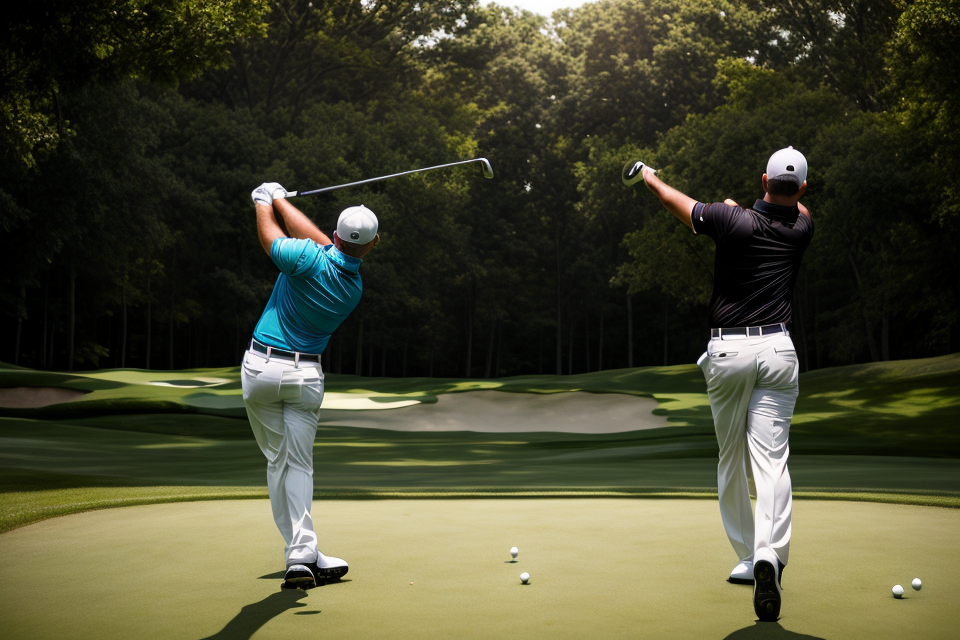
Golf is a sport that requires precision, control, and consistency. Achieving a good golf technique is crucial for any golfer who wants to improve their game. Good golf technique involves the right body mechanics, swing, and mental approach. In this article, we will explore the essential elements of good golf technique and how to develop them. We will discuss the importance of the grip, stance, and alignment, as well as the key elements of the swing, including the backswing and downswing. Additionally, we will touch on the mental aspect of golf and how it affects your technique. So, whether you’re a beginner or an experienced golfer, read on to discover the secrets to a great golf technique.
Good golf technique requires a combination of physical and mental skills. The essential elements of good golf technique include a proper grip on the club, a correct stance and alignment, a smooth and rhythmic swing, and proper use of the body’s natural movements. The golfer should also focus on maintaining a consistent and balanced weight shift during the swing, using the legs and hips to generate power, and keeping the head still and eyes on the ball. Additionally, a good golfer should have a strong sense of feel for the club and be able to make adjustments to their swing based on the conditions of the course and their own strengths and weaknesses. Ultimately, the key to good golf technique is a combination of practice, patience, and a willingness to learn and adapt.
Understanding the Basics of Golf Technique
Grip
When it comes to the essential elements of good golf technique, the grip is one of the most important aspects to consider. A proper grip can make all the difference in the world when it comes to your ability to control the golf club and hit the ball with accuracy and power. In this section, we will take a closer look at the correct way to hold the golf club, the importance of a strong grip, and common mistakes to avoid.
The Correct Way to Hold the Golf Club
The correct way to hold the golf club is known as the “neutral” or “strong” grip. This grip allows for maximum control and stability, allowing you to make a smooth, powerful swing. To achieve this grip, place the hands on the golf club with the palms facing towards the target. The left hand should be placed on the grip with the fingers wrapping around the club, while the right hand should be placed on the grip with the fingers resting on top of the left hand.
The Importance of a Strong Grip
A strong grip is essential for good golf technique because it allows you to control the golf club and hit the ball with accuracy and power. A weak grip can lead to a loss of control, causing the ball to slice or hook, and making it difficult to hit the ball with precision.
To develop a strong grip, it is important to practice gripping the golf club in the correct way, as described above. It is also important to use your fingers, rather than your palms, to grip the club. This will allow you to have a more secure hold on the club, and will help you to maintain control throughout your swing.
Common Mistakes to Avoid
There are several common mistakes that golfers make when it comes to their grip. One of the most common mistakes is to grip the club too tightly, which can lead to tension and a loss of control. It is important to grip the club with a firm, but relaxed grip, using your fingers to grip the club rather than your palms.
Another common mistake is to grip the club too loosely, which can also lead to a loss of control. It is important to grip the club with a firm grip, but not so tight that it is uncomfortable.
In addition to these common mistakes, it is also important to avoid gripping the club in an incorrect way. For example, some golfers may grip the club with their hands too far apart, or with their hands too close together. These grips can lead to a loss of control and can make it difficult to hit the ball with accuracy and power.
Overall, the grip is a crucial element of good golf technique, and it is important to hold the golf club in the correct way, grip it with a firm but relaxed grip, and avoid common mistakes such as gripping it too tightly or too loosely, or in an incorrect way. By paying attention to these details, you can improve your grip and enhance your overall golf technique.
Stance
The Proper Positioning of the Body
In golf, the stance refers to the position of the body from which the player executes the swing. A good stance is crucial to ensure that the player can make a smooth and powerful swing, while also maintaining balance and control over their movements. The body should be positioned in such a way that it allows the player to make a full shoulder turn and to maintain a consistent alignment throughout the swing.
The Alignment of the Feet, Knees, and Hips
Proper alignment of the feet, knees, and hips is also an essential aspect of a good golf stance. The feet should be positioned slightly wider than shoulder-width apart, with the toes pointing slightly outwards. This stance helps the player to maintain balance and stability throughout the swing. The knees should be slightly bent, providing flexibility and allowing the player to make a smooth transition from the setup to the swing. The hips should be positioned in such a way that they allow for a full shoulder turn, promoting a powerful and efficient swing.
The Role of the Shoulders and Arms
The shoulders and arms play a vital role in the golf swing, and a good stance should ensure that they are positioned correctly. The shoulders should be relaxed and positioned in line with the hips, allowing for a full and natural shoulder turn. The arms should be extended from the shoulders, allowing for a smooth and powerful swing. A good stance will ensure that the player can maintain control over their movements, while also promoting a smooth and efficient swing.
Swing
The golf swing is a complex motion that involves the coordination of several different body parts. It begins with the backswing, during which the club is raised behind the player’s head, and ends with the downswing, during which the club is brought down and through the ball. The transition between the two is crucial, as it determines the speed and accuracy of the shot.
The core and legs play a vital role in the golf swing. The core provides stability and balance, while the legs generate power and transfer energy to the rest of the body. A strong core and powerful legs can help players generate a more consistent and accurate swing.
Additionally, the swing also involves the proper use of the arms, wrists, and hands. The arms should be relaxed and extend naturally from the shoulders, while the wrists should remain flexible and in control throughout the swing. The hands should be positioned in a way that allows for maximum control over the club and a smooth release of the ball.
Overall, a good golf swing requires a combination of strength, flexibility, and control. It is essential to practice and develop good technique in order to achieve consistent and accurate shots.
Focus on the Fundamentals
Ball Position
When it comes to good golf technique, ball position is a crucial element that should not be overlooked. The position of the ball on the tee or in the fairway can have a significant impact on the accuracy and distance of your shots. Here are some key points to keep in mind when it comes to ball position:
- Ideal ball position for different shots: The ideal ball position can vary depending on the type of shot you are trying to hit. For example, when hitting a driver, the ball should be positioned towards the back of the tee for maximum distance. When hitting a lower shot, such as a chip shot or a pitch, the ball should be positioned closer to your body to ensure proper contact with the clubface.
- How to adjust ball position for different situations: The position of the ball can also be adjusted based on the situation you are in. For example, if you are trying to hit a shot over a hazard or a tall tree, you may need to move the ball forward in your stance to increase the loft of the club and help the ball get over the obstacle. Conversely, if you are trying to hit a shot that needs to stop quickly on the green, you may need to move the ball back in your stance to reduce the loft of the club and prevent the ball from rolling too far past the hole.
- The impact on accuracy and distance: Finally, the position of the ball can have a significant impact on both accuracy and distance. If the ball is positioned too far forward or too far back in your stance, it can affect the trajectory of the shot and make it more difficult to hit the ball with accuracy. By paying attention to the ideal ball position for each shot, you can improve your accuracy and distance, and ultimately lower your score.
Aim
When it comes to good golf technique, aim is a crucial element that should not be overlooked. Selecting a target and being able to focus on it is essential for a successful golf shot.
The importance of selecting a target
Selecting a target is crucial in golf because it allows the golfer to have a clear focus and direction for their shot. Without a specific target, a golfer may struggle to maintain accuracy and consistency in their shots.
The role of the mind in aiming
The mind plays a significant role in aiming. Golfers must be able to visualize their target and imagine the path of the ball as it travels towards it. This mental visualization helps to ensure that the golfer’s body follows through with the correct motion and direction.
How to improve aim
Improving aim in golf requires practice and focus. Golfers can practice aiming by selecting a specific target and taking multiple shots towards it. It is also important to pay attention to the body’s position and movement during the shot to ensure that the aim is consistent.
Additionally, using tools such as golf rangefinders or laser rangefinders can help golfers to more accurately select and measure their target distance. Regular practice and a consistent pre-shot routine can also help to improve aim and overall golf technique.
Posture
Having a good posture is one of the most important aspects of a good golf technique. A strong posture helps in creating a stable base, allowing for better control over the swing and promoting consistent ball striking. It also helps in preventing injuries and reducing fatigue.
The relationship between posture and swing is quite significant. A proper posture helps in aligning the body and the club, creating a straight and powerful swing. On the other hand, a poor posture can lead to a swing that is off-balance and lacks control. Therefore, it is essential to focus on posture to ensure a consistent and accurate swing.
Improving posture requires both physical and mental training. Here are some exercises that can help in improving posture:
- Chest Expansion Exercise: Stand up straight and pull your shoulders back. Place your hands on your chest and gently push your chest outward. Hold for a few seconds and repeat.
- Shoulder Blade Squeeze Exercise: Stand up straight and pull your shoulders back. Squeeze your shoulder blades together and hold for a few seconds. Release and repeat.
- Head and Neck Exercise: Stand up straight and tilt your head slightly forward. Hold for a few seconds and then tilt your head backward. Repeat a few times.
- Hip Flexor Stretch Exercise: Stand up straight and shift your weight onto one foot. Bend your front knee and grab hold of your ankle. Pull your heel toward your buttocks and hold for a few seconds. Repeat on the other side.
Remember, it takes time and practice to develop a good posture. Be patient and consistent with your exercises, and you will start to see improvements in your golf technique.
Develop Good Habits
Warm-up
The Importance of a Proper Warm-up
Before beginning any physical activity, it is crucial to prepare the body for the task ahead. In golf, a proper warm-up can help prevent injury, improve flexibility, and enhance overall performance. A warm-up should be tailored to the individual, taking into account their specific needs and goals. It should also include a variety of exercises to target different muscle groups and joints.
Stretching Exercises for the Upper and Lower Body
Stretching is an essential component of any warm-up routine. It helps to increase flexibility and range of motion, which can improve swing speed and accuracy. Stretching exercises should be performed slowly and gently, holding each stretch for at least 15-30 seconds. It is important to focus on the major muscle groups used in golf, including the shoulders, arms, back, and legs.
Swing Exercises to Loosen Up the Muscles
In addition to stretching, swing exercises can help to loosen up the muscles and improve coordination. These exercises should be performed with a lightweight club or no club at all, and should focus on the motion of the swing rather than power. Examples of swing exercises include wrist and forearm rotations, shoulder turns, and weight shifts. It is important to maintain proper form and posture during these exercises to prevent injury and maximize their effectiveness.
Practice
The role of practice in developing good technique
Practice is an essential element in developing good golf technique. It allows golfers to develop muscle memory, improve their swing mechanics, and build confidence on the course. Through practice, golfers can learn to make adjustments to their swing based on different course conditions and improve their overall performance.
Tips for effective practice
To maximize the benefits of practice, golfers should focus on the following tips:
- Warm-up: Start with a proper warm-up to prepare the body for the physical demands of golf. This can include stretching, light swinging, and hitting balls to get the muscles ready for the swing.
- Focus on the fundamentals: Focus on the basics of the golf swing, such as grip, stance, and ball position. These fundamentals are the building blocks of a good swing and should be mastered before moving on to more advanced techniques.
- Use visualization: Visualization is a powerful tool in golf. Golfers can mentally rehearse their swings, imagining themselves making perfect contact with the ball and feeling the sensations of a good swing.
- Record swings: Use video recording or slow-motion analysis to identify areas for improvement in the swing. This can help golfers identify their own flaws and work on correcting them.
- Practice under different conditions: Practice in different weather conditions, with different clubs, and on different parts of the course to prepare for a variety of situations that may arise during a round.
While practice is essential, it is also important to avoid common mistakes that can hinder progress. Some of these mistakes include:
- Over-practicing: Golfers should avoid practicing too much, as this can lead to fatigue and injury. It is important to allow the body time to rest and recover between practice sessions.
- Practicing bad habits: Golfers should be careful not to develop bad habits during practice. This can include using improper technique or practicing with an incorrect swing.
- Not varying practice: Golfers should vary their practice routine to avoid getting stuck in a rut. This can include practicing on different parts of the course, using different clubs, and practicing under different conditions.
- Ignoring the mental aspect: Golf is a mental game, and golfers should not neglect the mental aspect of their practice. This can include visualization, positive self-talk, and relaxation techniques.
Mental Game
Having a positive mental attitude is crucial for success in golf. This means that golfers should approach the game with a confident and optimistic mindset, believing in their ability to perform well. Negative thoughts and self-doubt can be detrimental to performance, so it’s important to focus on positive self-talk and visualization techniques.
Strategies for staying focused and calm include deep breathing exercises, visualization techniques, and pre-shot routines. These techniques can help golfers stay focused and composed, even in high-pressure situations.
Visualization is also an important aspect of the mental game. Golfers can visualize themselves making successful shots, and this can help to improve their confidence and performance on the course. By creating a mental image of the desired outcome, golfers can better focus their attention and make more effective shots.
In addition to these techniques, golfers should also practice good sportsmanship and maintain a positive attitude towards their opponents and the game itself. A positive mental attitude, combined with good sportsmanship, can help golfers to perform at their best and enjoy the game to the fullest.
Seek Professional Help
The benefits of working with a golf coach
- Personalized feedback and guidance
- A golf coach can provide personalized feedback and guidance on your technique, taking into account your unique strengths and weaknesses. They can help you identify areas for improvement and develop a plan to achieve your goals.
- Improved technique and performance
- A golf coach can help you improve your technique and performance by providing instruction on the proper mechanics of the swing, putting stroke, and chipping technique. They can also help you develop a pre-shot routine and improve your mental game.
- Access to advanced training tools and technology
- A golf coach can provide access to advanced training tools and technology, such as launch monitors, 3D swing analysis software, and biomechanical analysis. These tools can provide detailed feedback on your swing and help you make adjustments to improve your technique.
Working with a golf coach can provide many benefits for golfers of all skill levels. By receiving personalized feedback and guidance, improving technique and performance, and having access to advanced training tools and technology, golfers can take their game to the next level.
Finding the right coach
When it comes to improving your golf technique, seeking professional help is essential. However, not all coaches are created equal. Finding the right coach can make all the difference in your golf game. Here are some things to consider when looking for a golf coach:
What to look for in a coach
- Experience: Look for a coach who has a proven track record of success with golfers at your skill level.
- Credentials: Make sure the coach has the necessary qualifications and certifications to teach golf.
- Communication skills: A good coach should be able to communicate effectively and clearly with you.
- Golf knowledge: The coach should have a deep understanding of the mechanics of the golf swing and be able to explain complex concepts in a way that is easy to understand.
Questions to ask before hiring a coach
- What is your coaching philosophy?
- How do you tailor your coaching to meet the needs of each individual student?
- What is your experience working with golfers at my skill level?
- How often do you recommend lessons, and what is your pricing structure?
The importance of a good rapport with a coach
Having a good rapport with your coach is crucial for making progress in your golf game. You need to feel comfortable with your coach and feel like they understand your goals and needs. Look for a coach who is approachable, easy to talk to, and who makes you feel at ease. A good coach should also be able to motivate and inspire you to reach your full potential.
FAQs
1. What is good golf technique?
Good golf technique refers to the correct and efficient way of swinging a golf club to hit a golf ball accurately and consistently. It involves the correct grip, stance, and body movements, as well as the proper use of the club’s swing path and the follow-through. A good golf technique requires both physical and mental skills, and it can take time and practice to develop.
2. What are the essential elements of good golf technique?
The essential elements of good golf technique include a correct grip, a balanced and athletic stance, a smooth and efficient swing, and a focused mindset. A correct grip involves holding the club in the correct position with the hands, while a balanced and athletic stance involves standing in the correct position with the feet and knees bent. A smooth and efficient swing involves the correct use of the club’s swing path and the body’s movements, while a focused mindset involves being mentally prepared and aware of the shot at hand.
3. How can I improve my golf technique?
Improving your golf technique requires consistent practice and attention to detail. You can start by taking lessons from a qualified golf instructor who can provide feedback on your swing and offer suggestions for improvement. You can also practice your swing in front of a mirror or use slow-motion video analysis to identify any issues or flaws in your technique. It’s important to be patient and persistent, as developing good golf technique takes time and effort.
4. What are some common mistakes to avoid in golf technique?
Some common mistakes to avoid in golf technique include a weak grip, an unbalanced stance, an uneven swing, and a lack of focus. A weak grip can cause the club to twist or turn during the swing, while an unbalanced stance can throw off the body’s movements and affect the accuracy of the shot. An uneven swing can cause the ball to go off-target or suffer from a lack of power. Finally, a lack of focus can lead to mental distractions and affect the ability to execute a consistent and accurate shot.
5. Is there a secret to achieving good golf technique?
There is no secret to achieving good golf technique, but consistent practice and attention to detail are essential. It’s important to learn and understand the basic principles of the swing, such as the correct grip, stance, and body movements, and then practice them regularly. Additionally, developing a pre-shot routine can help to improve focus and consistency, while mental preparation and visualization can help to build confidence and reduce anxiety on the course. Ultimately, good golf technique is the result of hard work, dedication, and a willingness to learn and improve.


